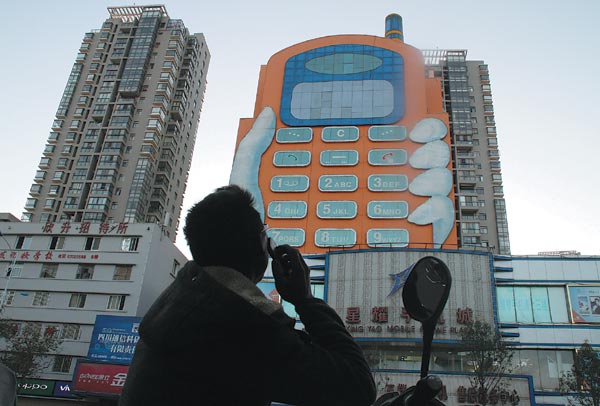Beautiful ... or ugly? In China, it's in the eye of the beholder
ByErik Nilsson/Zhang Lei/Zhao Xu/Peng Yining/Hu Yongqi
( China Daily ) Updated: 2014-11-08 09:06:34
 |
|
Xingyao Cellphone City stands in downtown Kunming, Yunnan province. Wu Changqing / China Daily |
As click-bait slideshows of China's "weird" buildings trend globally, those living in these structures' shadows see more local, closer-up and intimate vantages. Yet their views are also scattered along the adore-to-abhor gamut, although often for different reasons than for outsiders.
Some consider these constructions time capsules-monuments to moments in China's development. The mammoth mobile phone clasped by a humungous hand in Yunnan province's capital Kunming has been a landmark not only since but also to the 1990s.
"Many locals know the building and directed friends to the shopping center before the e-commerce era," resident Yang Tian says.
Xingyao Cellphone City's facade is pre-touchscreen-it harks to the brick-phone era. Its 15 "buttons" are windows and the "screen" is a colossal display advertising gizmos. "The building may be used for other businesses later, since most people now buy cellphones and other gadgets online," Yang says.
"But I hope the building will retain its appearance because it recalls olden days."
The 31-year-old engineer believes the "cool" building has contributed to China's cellphone sector. "Friends from elsewhere ask me to photograph them in front of it," he says. "What fun for them!"
Civil servant Guo Xiaotian, 27, agrees its distinctive shape and blazingly yellow hue arrests attention.
Yang says: "Neighbors considered it novel from the outset. I thought it wasn't so strange. It portrays the industry inside."
Peculiar buildings can serve as landmarks not only in terms of cultural locales but also geographic locations, residents say. Take Beijing's Tianzi Hotel, which holds a Guinness World Record as the world's largest image-based building. The 10-story structure takes the forms of the gods Fu, Lu and Shou-deified embodiments of fortune, prosperity and longevity you can sleep in.
"It's huge so you can use it like a compass if you miss your road," says Yuan Li, who owns a nearby apartment. "I see it every day when I drive home and know I'll soon be home."
He points out Tianzi has been "ridiculed for years. But it's so much better than surrounding buildings-especially those with white ceramic tiles. They look like the insides of public toilets."
Narrow, white tiles were status symbols decades ago and persist as standard interiors of public restrooms.
Inner Mongolia autonomous region native Zhang Yuan says the 244-meter-high Olympic observation tower he sees from his Beijing university dorm window is a landmark when he's lost in the area. (Netizens mockingly call the structure "the nails".)
The looming construction takes on deeper meaning for his roommate Wang Junxiang. "It looks contemporary and shows Beijing is a mix of modern and traditional," the 19-year-old says. "We should protect old buildings to preserve the past and use new edifices to envision the future."
Zhang flips through photos on his iPhone showing the circular crests illuminated in different neon hues. "It reminds me of heaven because you only see the illuminated tops at night," he says.
|
|
|
|
|
|
|
|

























 Raymond Zhou:
Raymond Zhou: Pauline D Loh:
Pauline D Loh: Hot Pot
Hot Pot Eco China
Eco China China Dream
China Dream China Face
China Face






